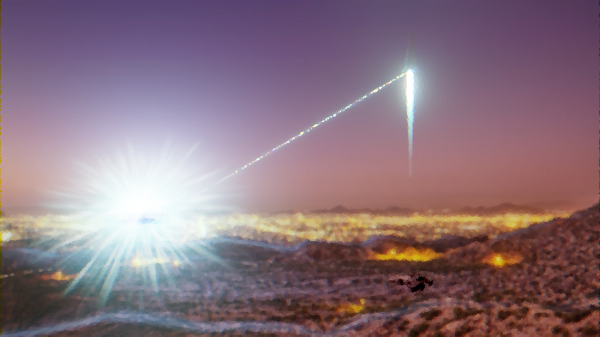BY LETTER
Laser-launched surface-to-orbit craft
Technology > Application > Transportation > Atmospheric Transport
Technology > Application > Transportation > Surface-To-Orbit Transport
Technology > Application > Transportation > Surface-To-Orbit Transport
Beamed-energy propulsion to orbit | |
 Image from Copyright Lilly Harper | |
| This laser-thermal craft uses laser beams to heat the propellant | |
Variants include:
Laser-thermal rocket which uses a high-powered laser and a heat-exchanger to heat the propellant, and can be used for launches or as a remote power source for craft in space.
Ablative laser propulsion requires a solid or liquid propellant mass (often an ice of some sort) which can be heated from below and forced out of a rocket bell in the desired direction.
Pulsed Atmospheric Plasma Production uses the ambient atmosphere as propellant, saving on mass considerably. Atmospheric gas flows into the propulsion chamber between each pulse, thereby renewing the working fluid externally.
Laser-electric propulsion converts laser radiation into electricity, which is then used to power a motor or an electric propulsion system. Often used as a method to accelerate a craft partway to space before another system takes over, or as a propulsion method in vacuum. Craft ascending beanstalks are often powered in this way.
Laser propulsion is often used in tandem with a space runway acceleration system, where the payload is accelerated along an inclined plane by maglev traction. The lasers take over after the end of the runway track.
Image from Anders Sandberg | |
| HELL - High Energy Laser Launch site at the Baykonur Republic. | |
The propellant was ice, dyed black, heated into steam by the launch lasers along the flight path. Each laser was powered by 5 x 10 gigawatt nuclear reactors, able to launch one vehicle each hour.
Related Articles
Appears in Topics
Development Notes
Text by Anders Sandberg
Additional material by Steve Bowers
Initially published on 02 May 2013.
Additional material by Steve Bowers
Initially published on 02 May 2013.
Additional Information
Image 'Laser thermal launch' copyright by Lilly Harper used with permission. Please contact her for conditions of re-use at https://beaconsinthedark.wordpress.com/.






